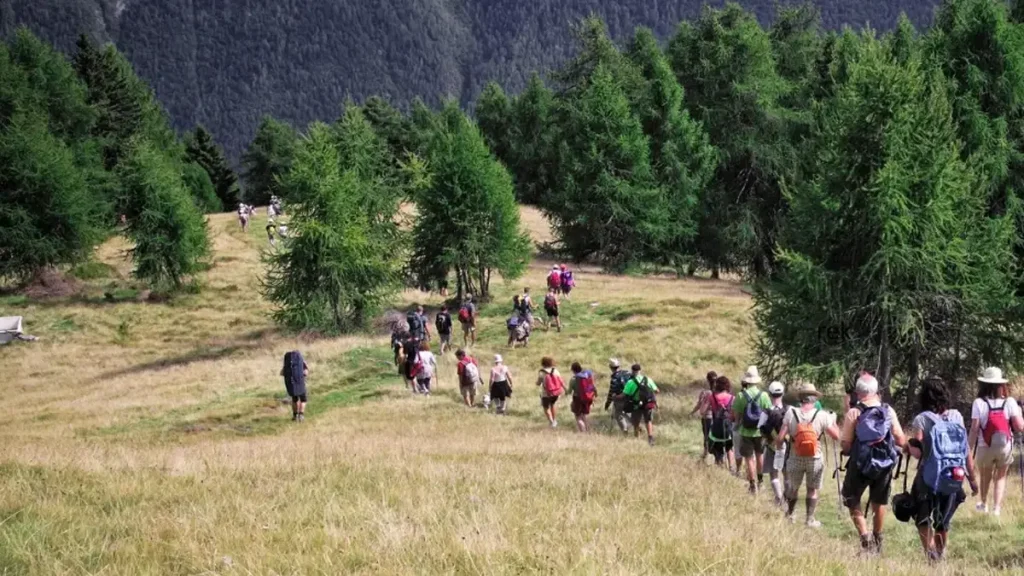
Would you trek to where the Ganga is literally born? Gangotri Trek isn’t a mountaineering trek—though an experience step-by-the-minute-and-timeless-adventure through the wild heart of the Himalayas. Ancient temples, thundering rivers, and sleeping glaciers—each turn on this trek is as if nature is reading its oldest tale. If you want to visit chardham you can book chardham by helicopter.
Why Gangotri Trekking Stands Out as a Special Trek Unlike Any Other
When you receive “length” of trekking Gangotri, you envision a standard hill climb. This one, though, isn’t just alive but is full of life. Each turn, something new in your ears—the different sounds of melting snow, the screech of shearing winds, or the boom of the Bhagirathi River, which flows along in concert with you. In such a place, the air is divine, nay, pure. You don’t just climb mountains; you climb faith, history, and silence.
Following the recent floods, mid-September 2025 also witnessed the trail become open and till date, only handfuls of groups have had the pleasure of this newly opened trail. The authorities re-tarred the Gangotri trail following the Harsil-Dharali landslips, so trekkers expect this season to be one of the most secure yet unexplored.
Trekkers this year are going to have the pleasure of experiencing the Himalayas in their most wild and spellbinding form.
The Gangotri Trek: An Itinerary
On Day 1, the tour begins as you arrive in the scenic village of Gangotri (3,100 m). The moment you step in, the soft ringing of temple bells fills your ears, and the fresh mountain air carries the soothing scent of pine all around.
Day 2 involves the trek having begun over a forest road on which deodar and pine trees of massive size are encountered. The glacial Bhagirathi River flows by, crystal clear.
Day 3 marks the departure from the thick woods and sees the mountain stand exposed and bare as one walks towards Bhojbasa (3,900 m). There are glimpses of glacial rock, ice cracks in the distance, and blue sheep grazing.
Day 4 is a difficult but rewarding experience with the difficult trek to get to Gaumukh (4,023 m), the actual mouth of the glacier. Here the Ganga starts life as a small rivulet which one can be seen spouting from the ice.
On Day 5, trekkers take on a tough but rewarding climb to Tapovan (4,463 m), a beautiful high-altitude meadow. The mighty peaks of Shivling and Meru rise tall in the background, creating a view so grand that it leaves everyone silent. Many describe Tapovan as one of the most peaceful places in the entire Himalayas.
The midpoint of the journey, Day 6, is provided entirely for relaxation at Tapovan. You take time for just walking around the meadow, witnessing how the sun changes the color of the mountaintops. You do some quiet meditation, or you write thoughts in your journals.
On Day 7, you start the way down, beginning the descent to Chirbasa. You feel every step as special; you see the same mountains, but they hold a new story for you after you achieve the higher ascent.
The final descent to Gangotri on Day 8 is experienced as a nostalgic blend. Exhaustion is felt, yet it is tempered with calm and contentment. Each noise and odor is heightened, as if a personal farewell is being offered by the mountain itself.
Best Time to Travel and Precautions
May and June and September and October are the ideal months. Snowmelt is experienced by May, while by September monsoon clouds dispel. In 2025, yatra season started on May 10 and will run up to early November.
You have to leave from a registered office such as LIH Travel since the forest department is granting limited permits on a daily basis. You must halt at Chirbasa and Bhojbasa, where you submit your records. Authorities establish rules for security because parts of the tracks are sensitive and subject to rockfalls.
Since the 2025 floods, authorities have taken additional safety precautions. Before departure, guides now give trekkers new route briefings, and you can call rescue teams from the area in case of an emergency. Teams inspect and clear the trail for groups to trek.
What Trekkers Have to Say About Gangotri Trekking
One Pune tourist in his early twenties had this to say,
“I had thought of Gangotri as I would of any other yatra trek. But when I saw the mouth of the glacier, I was paralysed for ten minutes. The silence shocked me more than ever in my life by any sound I have ever heard.”
A second third trekker who had gone in a small group said,
“The climb to Tapovan was exhausting. The rocks moved under our feet. But the sunrise from Tapovan made every bruise worth it. It was not just a view—it felt like a blessing.”
Individuals frequently return transformed. Numerous individuals state that they discover something they did not realize they were missing—peace, patience, or simply a perception of being tiny in a huge universe.
What You See and Feel in the Way
The Gangotri Glacier extends for 30 kilometers and is approximately 2 kilometers broad. Being ahead of the Gangotri Glacier is being ahead of a closed timescape. There is a cow-mouthed tunnel called the Gaumukh glacier by which river Bhagirathi, being a chief tributary of the Ganga, flows.
You have mountains to gaze upwards at—Shivling, Meru, and Bhagirathi I, II, and III—stately sentries looming above you. Tapovan, the 4,400-meter green meadow country, is a white ocean of peaks above and a green ocean below.
But the mountain is unique. The glacier retreated year by year step by step. Gangotri guides report that the ice retreated almost a kilometer in recent decades. It is a reminder that the view is priceless and vulnerable.
Why LIH Travel Makes the Trek Safer and Better
LIH Travel is committed to erasing Gangotri trekking from an itinerary list. For this reason, the trip is upgraded:
- Local current information: Guides reside close to Uttarkashi and possess firsthand knowledge about weather and trail conditions.
- Low-impact groups: We maintain low-impact groups to provide personal attention to all and low impact to nature.
- Mountain-raised staff: Guides are rescue and first aid trained.
- Balanced itinerary: We add acclimatization days in order to prevent altitude sickness.
- Comforting camps: We have well-insulated tents, plain but clean food, and bring clean water along with us.
- Genuine moments: We take time for meditation, sunrise viewing, and moments of silence—mountains also need silence.
Every LIH Travel trek is designed so you’ll feel you are part of something—not rushed.
Instant Answers to Common Questions
Can newbies join?
Yes. A guide can do the Gangotri trek for beginners. Running or walking lightly a few weeks prior to visiting is advised.
Is it safe after floods?
Yes, it’s open once again. The pieces that were broken are put together, and treks were commenced safely with guides.
Will there be cell networks?
You shall receive signals up to Gangotri town. Phone is silent then, and speaks only the hill.
Do I need a permit?
Yes. Per day trekkers are regulated after Bhojbasa. Everything in the permit arrangement is done by LIH Travel.
Final Thoughts
The Gangotri trek is not ascending a glacier, but discovering serenity in turmoil. One of the few places in this world where you are still capable of hearing nature at its best in its natural state. Every noise, every wind, every color has something to learn.
2025 trekking season is unique. The trek is new, safe, and far from the crowds of tourists. The moment has come to experience the Himalayas as nature had wanted the treks to be toured—silence, sanctity, and colours.
When you hike with LIH Travel, you don’t simply hike a trail. You hike upon stories, faith, and an uncorrupted bundle of India’s spirit that has remained intact for centuries. And when you return home, a portion of that hill will remain with you always.


